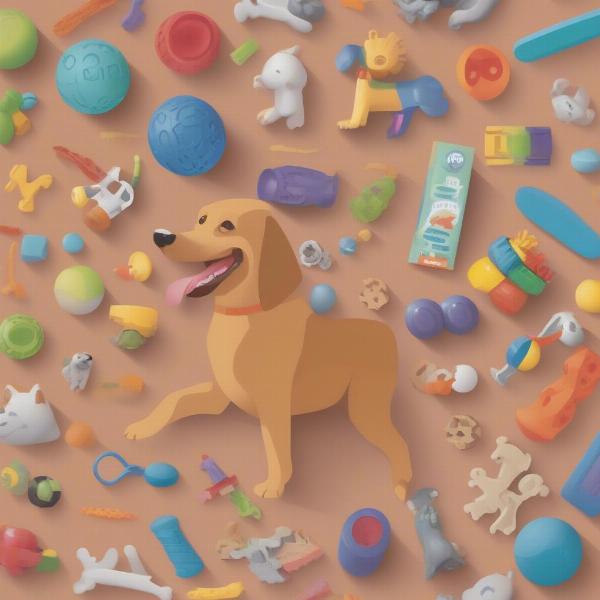Challenging dog toys are essential for a dog’s mental and physical well-being. They offer more than just amusement; they provide crucial stimulation that combats boredom, reduces anxiety, and can even prevent destructive behaviors. Choosing the right challenging dog toy, however, can feel overwhelming with so many options available. This article will guide you through selecting the perfect brain-busting toys for your furry friend, ensuring hours of fun and enrichment.
Why Challenging Dog Toys are Important
Dogs are intelligent creatures that need mental stimulation just as much as they need physical exercise. Challenging dog toys provide this vital mental workout. They encourage problem-solving, improve cognitive function, and help your dog learn new skills. A mentally stimulated dog is a happy dog, less prone to boredom-induced behaviors like excessive barking, chewing, or digging.
Choosing the Right Challenging Dog Toy
Not all challenging dog toys are created equal. The best toy for your dog depends on their breed, age, size, and play style.
- Puzzle Toys: These toys often involve hiding treats inside compartments that the dog must figure out how to open. They come in varying levels of difficulty, from beginner to expert.
- Interactive Treat Dispensing Toys: These toys dispense treats as the dog plays with them, providing a reward for their efforts. They can be balls, bones, or even plush toys.
- Durable Chew Toys: For dogs who love to chew, durable toys made from tough materials like rubber or nylon can provide a satisfying challenge. Look for toys with interesting textures or shapes to keep them engaged.
- Hide-and-Seek Toys: These toys can be as simple as a favorite toy hidden under a blanket or as complex as a set of interactive puzzle toys. Hiding toys encourages your dog to use their sense of smell and problem-solving skills.
Matching the Toy to Your Dog’s Personality
Consider your dog’s personality and play style when choosing a challenging toy. A highly energetic dog might benefit from a treat dispensing ball that keeps them moving, while a more laid-back dog might enjoy a puzzle toy that requires quiet contemplation. dog toys without squeakers can be a great choice for sensitive dogs who are easily startled by noise.
Introducing New Challenging Toys
When introducing a new challenging toy, start with something relatively easy. Show your dog how the toy works and encourage them to explore it. Offer praise and rewards when they make progress. Gradually increase the difficulty as your dog becomes more proficient.
Keeping it Interesting: Rotating Toys
Even the most challenging toy can become boring if your dog plays with it constantly. Rotate your dog’s toys regularly to keep them engaged and prevent them from losing interest. This simple strategy can maximize the mental stimulation your dog receives from their toys.
 A dog surrounded by a variety of challenging toys
A dog surrounded by a variety of challenging toys
Conclusion
Challenging dog toys are an essential part of providing a stimulating and enriching environment for your canine companion. By carefully selecting toys that match your dog’s personality, age, and play style, you can help them stay mentally sharp, physically active, and emotionally fulfilled. Remember to introduce new toys gradually, rotate them regularly, and always supervise your dog’s playtime to ensure their safety. Investing in challenging dog toys is an investment in your dog’s overall well-being.
FAQ
- How do I know if a toy is too challenging for my dog? If your dog becomes frustrated or loses interest quickly, the toy may be too difficult. Try a simpler toy and gradually work your way up to more challenging ones.
- Are challenging dog toys only for puppies? No, dogs of all ages benefit from mental stimulation. Senior dogs can especially benefit from challenging toys to help keep their minds sharp.
- Can challenging dog toys help with separation anxiety? Yes, providing your dog with a challenging toy before you leave can help distract them and reduce anxiety.
- How often should I replace my dog’s toys? Replace any toys that are broken or pose a choking hazard. Regularly inspect toys for wear and tear.
- What if my dog isn’t interested in challenging toys? Try different types of toys or make the toy more appealing by adding treats or scents.
- Can challenging toys be used for training? Absolutely! Many challenging toys can be incorporated into training exercises to reinforce positive behaviors and provide mental stimulation.
- Are homemade challenging dog toys a good option? Yes, you can create simple challenging toys at home using items like empty plastic bottles or cardboard boxes. Just make sure they are safe and durable.
ILM Dog is a leading international online resource for dog owners, dedicated to providing expert advice on all aspects of canine care and companionship. From breed selection and health to training, nutrition, and grooming, we offer a wealth of practical and reliable information to help you provide the best possible care for your furry friend. We also offer guidance on dog-friendly travel and a curated selection of top dog pickleball and other products and accessories. For expert advice and personalized support, contact our team of experienced dog professionals. Email: [email protected], Phone: +44 20-3965-8624. ILM Dog is here to support you every step of the way on your dog ownership journey.